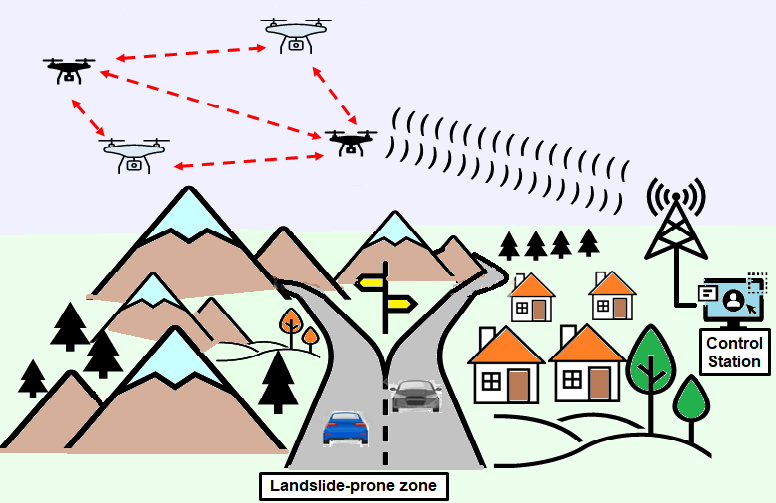Research
Design, modelling and control of UAV swarms for remote sensing and monitoring

The loss of life, assets and economic output that accompany natural disasters can be minimised by prompt action based on sufficient and timely information. UAV-based remote sensing and monitoring present a cheaper alternative to satellite imaging, with the potential for superior data capture rates and precision. There are many applications of UAV-based sensing and monitoring including infrastructure security, habitat monitoring, traffic control, environmental monitoring, flood monitoring, leakage detection in water distribution network, healthcare and precision agriculture. The power system is one of the main hurdles for UAV, especially the rotary wing UAV, to be in flight for a longer time as required to complete a task. This research aims to develop and build a high-endurance solar-powered unmanned aerial vehicle and its network capable of vertical take-off and landing, hovering and holding its position for the above applications. The project will involve the investigation of the UAV design: optimum topology, powering with solar energy, flight time duration, integration between decision algorithms and output signals of multiple sensors, accurate machine learning and Neural Network Training to determine the exact target location and reliable techniques for collision avoidance between members of the UAV network.
One noteworthy project funded under the S&E Industry Studentship Model is centred around the "Solar-powered VTOL UAS-based Intelligent Sensing/Monitoring Applications of Precision Agriculture." This initiative explores the integration of solar energy to power Vertical Take-Off and Landing (VTOL) Unmanned Aerial Systems (UAS), incorporating intelligent sensing technologies like high-resolution imaging and multispectral sensors.
 The loss of life, assets and economic output that accompany natural disasters can be minimised by prompt action based on sufficient and timely information. UAV-based remote sensing and monitoring present a cheaper alternative to satellite imaging, with the potential for superior data capture rates and precision. There are many applications of UAV-based sensing and monitoring including infrastructure security, habitat monitoring, traffic control, environmental monitoring, flood monitoring, leakage detection in water distribution network, healthcare and precision agriculture. The power system is one of the main hurdles for UAV, especially the rotary wing UAV, to be in flight for a longer time as required to complete a task. This research aims to develop and build a high-endurance solar-powered unmanned aerial vehicle and its network capable of vertical take-off and landing, hovering and holding its position for the above applications. The project will involve the investigation of the UAV design: optimum topology, powering with solar energy, flight time duration, integration between decision algorithms and output signals of multiple sensors, accurate machine learning and Neural Network Training to determine the exact target location and reliable techniques for collision avoidance between members of the UAV network.
One noteworthy project funded under the S&E Industry Studentship Model is centred around the "Solar-powered VTOL UAS-based Intelligent Sensing/Monitoring Applications of Precision Agriculture." This initiative explores the integration of solar energy to power Vertical Take-Off and Landing (VTOL) Unmanned Aerial Systems (UAS), incorporating intelligent sensing technologies like high-resolution imaging and multispectral sensors.
The loss of life, assets and economic output that accompany natural disasters can be minimised by prompt action based on sufficient and timely information. UAV-based remote sensing and monitoring present a cheaper alternative to satellite imaging, with the potential for superior data capture rates and precision. There are many applications of UAV-based sensing and monitoring including infrastructure security, habitat monitoring, traffic control, environmental monitoring, flood monitoring, leakage detection in water distribution network, healthcare and precision agriculture. The power system is one of the main hurdles for UAV, especially the rotary wing UAV, to be in flight for a longer time as required to complete a task. This research aims to develop and build a high-endurance solar-powered unmanned aerial vehicle and its network capable of vertical take-off and landing, hovering and holding its position for the above applications. The project will involve the investigation of the UAV design: optimum topology, powering with solar energy, flight time duration, integration between decision algorithms and output signals of multiple sensors, accurate machine learning and Neural Network Training to determine the exact target location and reliable techniques for collision avoidance between members of the UAV network.
One noteworthy project funded under the S&E Industry Studentship Model is centred around the "Solar-powered VTOL UAS-based Intelligent Sensing/Monitoring Applications of Precision Agriculture." This initiative explores the integration of solar energy to power Vertical Take-Off and Landing (VTOL) Unmanned Aerial Systems (UAS), incorporating intelligent sensing technologies like high-resolution imaging and multispectral sensors.
